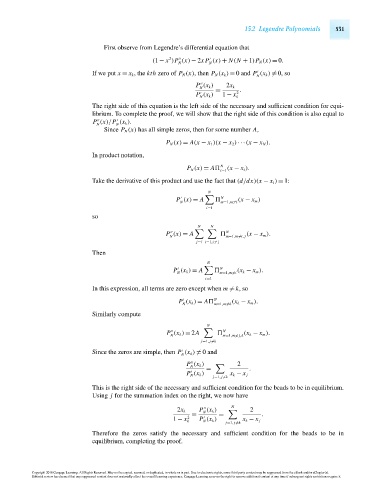Page 551 - Advanced_Engineering_Mathematics o'neil
P. 551
15.2 Legendre Polynomials 531
First observe from Legendre’s differential equation that
2
(1 − x )P (x) − 2xP (x) + N(N + 1)P N (x) = 0.
N
N
If we put x = x k ,the kth zero of P N (x), then P N (x k ) = 0 and P (x k ) = 0, so
N
P (x k ) 2x k
N
= .
P (x k ) 1 − x 2
N k
The right side of this equation is the left side of the necessary and sufficient condition for equi-
librium. To complete the proof, we will show that the right side of this condition is also equal to
P (x)/P (x k ).
N N
Since P N (x) has all simple zeros, then for some number A,
P N (x) = A(x − x 1 )(x − x 2 )···(x − x N ).
In product notation,
P N (x) = A N (x − x i ).
i=1
Take the derivative of this product and use the fact that (d/dx)(x − x i ) = 1:
N
P (x) = A N (x − x m )
N m=1,m =i
i=1
so
N N
P (x) = A N (x − x m ).
N m=1,m =i, j
j=1 i=1,i = j
Then
N
P (x k ) = A N (x k − x m ).
N m=1,m =i
i=1
In this expression, all terms are zero except when m = k,so
N
P (x k ) = A m=1,m =k (x k − x m ).
N
Similarly compute
N
N
P (x k ) = 2A m=1,m = j,k (x k − x m ).
N
j=1, j =k
Since the zeros are simple, then P (x k ) = 0 and
N
P (x k ) 2
N
= .
P (x k ) j=1, j =k x k − x j
N
This is the right side of the necessary and sufficient condition for the beads to be in equilibrium.
Using j for the summation index on the right, we now have
N
P (x k ) 2
2x k N
= = .
1 − x 2 P (x k ) x k − x j
N
k
j=1, j =k
Therefore the zeros satisfy the necessary and sufficient condition for the beads to be in
equilibrium, completing the proof.
Copyright 2010 Cengage Learning. All Rights Reserved. May not be copied, scanned, or duplicated, in whole or in part. Due to electronic rights, some third party content may be suppressed from the eBook and/or eChapter(s).
Editorial review has deemed that any suppressed content does not materially affect the overall learning experience. Cengage Learning reserves the right to remove additional content at any time if subsequent rights restrictions require it.
October 14, 2010 15:20 THM/NEIL Page-531 27410_15_ch15_p505-562

